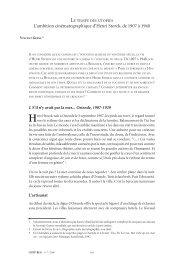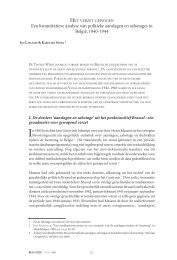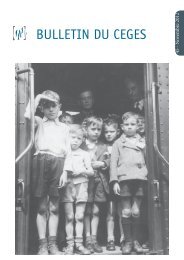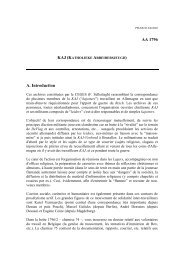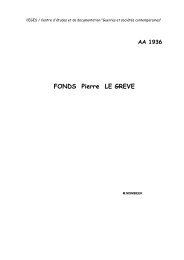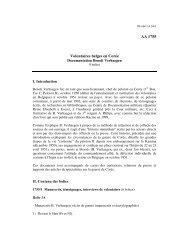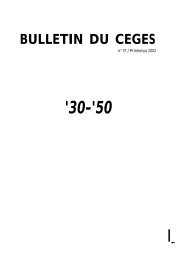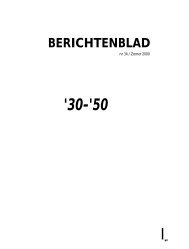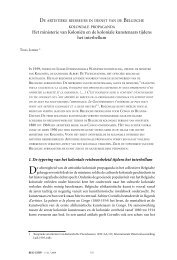Artsen Zonder Grenzen-België, genese van een atypische NGO ...
Artsen Zonder Grenzen-België, genese van een atypische NGO ...
Artsen Zonder Grenzen-België, genese van een atypische NGO ...
You also want an ePaper? Increase the reach of your titles
YUMPU automatically turns print PDFs into web optimized ePapers that Google loves.
SAMENVATTINGEN / RÉSUMÉS / SUMMARIESJEAN-BENOÎT FALISSEHUMANITAIRE ONDERNEMERS<strong>Artsen</strong> <strong>Zonder</strong> <strong>Grenzen</strong>-<strong>België</strong>, <strong>genese</strong> <strong>van</strong> <strong>een</strong> <strong>atypische</strong> <strong>NGO</strong>,1980-1987Sinds het einde <strong>van</strong> de jaren 1970 heeft de vereniging <strong>Artsen</strong> <strong>Zonder</strong> <strong>Grenzen</strong> (AZG)/ Médecins sans frontières (MSF) zich stilaan doen gelden als <strong>een</strong> spilfiguur in dewereld <strong>van</strong> de humanitaire hulp en ontwikkelingssamenwerking. Oorspronkelijk <strong>van</strong>Franse origine, zwermde de organisatie uit, wat in 1980 resulteerde in de oprichting<strong>van</strong> <strong>een</strong> Belgische sectie. Op enkele jaren tijd functioneerde de Belgische afdelingmet vergelijkbare financiële, menselijke en technische middelen als die <strong>van</strong> haarFranse moederorganisatie. Tevens ontwikkelde ze haar eigen manier <strong>van</strong> actie enorganisatie.Gesteund op o.m. onuitgegeven interne documenten en interviews <strong>van</strong> gewezenleiders <strong>van</strong> AZG, ontleedt dit artikel het raderwerk <strong>van</strong> de ‘machine AZG’ in deeerste jaren <strong>van</strong> haar bestaan (1980-1987). In tegenstelling tot de clichés, die al tedikwijls de enige beschikbare ‘geschiedenissen’ zijn over Niet GouvernementeleOrganisaties (<strong>NGO</strong>’s), treedt AZG–<strong>België</strong> naar voren als <strong>een</strong> organisatie met<strong>een</strong> hoge graad <strong>van</strong> professionalisme. Bezield door <strong>een</strong> nieuw concept <strong>van</strong> huma -nitaire hulp – technisch en gecentreerd op het apolitieke – bouwde AZG-<strong>België</strong> <strong>een</strong> operationele structuur uit die dicht bij <strong>een</strong> klassieke privé-ondernemingstaat.Dankzij <strong>een</strong> kwaliteitsvol rekruteringsreservoir <strong>van</strong> jonge gediplomeerden <strong>van</strong> hetInstituut voor Tropische Geneeskunde in Antwerpen ontwikkelt de organisatieallerlei hulpmiddelen en vaardigheden zoals kits, guide-lines en opleidingen. Deeerste langdurige missie <strong>van</strong> AZG in Tsjaad speelde daarin <strong>een</strong> belangrijke rol. DeBelgische sectie AZG genoot al snel <strong>een</strong> bijzonder goede reputatie en haar imago, datals model naar voren werd geschoven, ging alle lagen <strong>van</strong> de gem<strong>een</strong>schap doordringen,inclusief de instellingen. De organisatie kon zo op belangrijke institutionelefinancieringen rekenen, in het bijzonder <strong>van</strong> het Europees Ontwikkelingsfonds (EOF),en op diverse specifiek technische samenwerkingsverbanden (universiteiten, <strong>NGO</strong>’s,ondernemingen).Tot slot komt het artikel terug op de identiteitscrisis en de crisis bij de leiding die AZGin het midden <strong>van</strong> de jaren 1980 doormaakte. Die crisis bracht de Belgische sectieAZG ertoe om het apolitieke <strong>van</strong> hun discours en hun interventies te herbevestigen,ja heruit te vinden.CHTP-BEG - N° 21 / 2009311
Samenvattingen / Résumés / SummariesJEAN-BENOÎT FALISSEHUMANITARIAN CONTRACTORSMédecins sans frontières Belgium :the genesis of an atypical non-governmental organisation, 1980-1987From the end of the 1970s onwards, the Médecins sans frontières (MSF) movementestablished itself as a major actor in the world of humanitarian aid andcooperation in development. Initially French in origin, the organisation expanded,and a Belgian section was established in 1980. Within a few years, this Belgian sectionwas functioning on a financial, human and technical scale comparable to that of itsFrench parent organisation, and began to develop its own methods of action andorganisation.Through the use of unpublished internal documents and interviews with former leadingfigures in MSF, this article analyses the workings of the machinery of MSF Belgiumduring its first years of existence (1980-87). What emerges from behind the clichés whichall too often constitute the only available history of non-governmental organisations,is an organisation characterised by a high level of professionalism. Motivated by a new– more technical and consciously apolitical – concept of humanitarian aid, MSF Belgiumput in place an operational structure which resembled closely that of a classical privatebusiness. Relying on high-quality recruitment from the Institute of Tropical Medicine atAntwerp, the organisation developed particular mechanisms (kits, guidelines, trainingcourses, etc) and forms of expertise, which had in many cases b<strong>een</strong> developed inresponse to the challenges encountered during its first long-term mission in Chad. Asa consequence, MSF Belgium rapidly came to enjoy a reputation for excellence, and itsimage became a model to be emulated by the wider society, including by institutions.This enabled it to receive important financial support, notably from the EuropeanDevelopment Fund, as well as to develop technical partnerships with universities, nongovernmentalorganisations and companies.In a final section, this article re-examines the crisis of identity and leadership whichMSF experienced in the middle of the 1980s, and which led MSF Belgium to reaffirmand reinvent the apolitical character of its discourse and interventions.KOEN AERTSLA RÉPRESSION DE LA COLLABORATION APRÈS LA SECONDE GUERRE MONDIALEReprésentation et rechercheLa représentation et la perception de la répression après la Seconde Guerre mondialefut pendant longtemps en Belgique plutôt matière à débat sociétal qu’à rechercheshistoriques (académiques). Les tentatives pour contenir le passé de guerre dans312
Samenvattingen / Résumés / Summariesun discours officiel national apparurent très vite infructueuses. La représentationdominante à propos de la répression de la collaboration n’était au départ rien deplus qu’une construction nationaliste flamande. La répression était interprétéedans ces milieux comme un règlement de compte belge ou même francophone àl’égard du Mouvement flamand. Le statut de victime fut activement cultivé sur leplan politique et devint partie intégrante d’une revendication d’identité propre à partentière.C’est seulement dans les années 1980 que cette représentation dominante fut pourla première fois mise à mal avec succès. Les émissions de Maurice De Wilde surl’Ordre nouveau battirent en brèche le discours monotone (nationaliste) flamand.Les polémiques exacerbées à la télévision ainsi que les violents billets d’opinionet lettres des lecteurs dans la presse écrite montrèrent la nécessité d’une recherchehistorique de qualité sur ce passé. Cette période marqua aussi le début des rechercheshistoriques scientifiques sur le passé de guerre dans différentes universités belges. Àla Katholieke Universiteit Leuven, Luc Huyse, Steven Dhondt et leur équipe avaientcommencé ce qui en 1991 déboucherait sur la première étude fondamentale et élaboréede manière scientifique sur la répression de la collaboration. Comme sociologues (dudroit), ils constataient que la Belgique était malade des années 40. Cela fut la mêmeannée encore souligné par le succès électoral de l’extrême droite en Flandre. Huyseet Dhondt concluaient que la Belgique était confrontée à un traumatisme. Tant sur leplan législatif que scientifique, on chercha cependant de manière assidue des remèdespour extirper cette maladie. Au niveau fédéral, on adopta en 1995 la loi contre lenégationnisme et le Parlement flamand formula en 2002 quelques recommandationsau sujet de la manière de traiter le passé de guerre. Le traumatisme parut de cette façonquelque peu conjuré au niveau de la collectivité sociétale et politique. Par le rejet etla condamnation du passé fautif, la Flandre essayait d’entrer dans le 21 e siècle sur desbases saines.L’actualité du débat perdit en pertinence et l’accent sur un passé non assumé sedéplaça par le biais de nouveaux sujets et angles d’approche vers l’étude d’unpassé insoupçonné, qu’elle soit ou non réalisée dans une perspective comparativeinternationale. L’instrumentalisation du passé en vue de soutenir la nation, qu’elleait été flamande ou belge, a été remplacée par une approche plus historique où demanière assez paradoxale cette fois, du moins parmi les historiens (académiques),un large consensus paraît tout de même se développer par rapport à la noirceurdu passé de guerre et à sa liquidation. L’attention est de plus en plus portée sur lacollaboration en Belgique francophone et la thèse d’une répression anti-flamande aperdu de sa vigueur.313
Samenvattingen / Résumés / SummariesKOEN AERTSTHE REPRESSION OF COLLABORATION IN BELGIUMAFTER THE SECOND WORLD WARRepresentation and ResearchIn Belgium, the repression which occurred after the Second World War for a longtime remained more a subject of social debate than of (academic) historical research.The attempts made to confine the wartime past within a national official discoursesoon proved to be fruitless. Instead, the dominant perception of the repression ofcollaboration was at the outset nothing more than a Flemish nationalist construction.According to this account, the repression was perceived as simply a Belgian or evenfrancophone act of revenge against the Flemish movement. In this way, the conceptof victimhood was actively politically cultivated, and became an integral element of aclaim to a distinct identity.This dominant interpretation was only successfully broken in the 1980s. The broadcastsof Maurice De Wilde on the New Order challenged this monotone Flemish (nationalist)discourse. The violent polemics to which this gave rise on the television, as well as theopinion pieces and readers’ letters published in the press, demonstrated the need forserious historical research on this element of the past. It was at this time that scientifichistorical research began in various Belgian universities on the subject of the wartimepast. At the Catholic University of Leuven, Luc Huyse, Steven Dhondt and theircollaborators undertook the research which resulted in the publication of the firstfundamental and scientifically based study of the repression of collaboration in 1991.As (legal) sociologists, they concluded that Belgium was suffering from an illness rootedin its wartime past; a conclusion that appeared to be reinforced in the same year by theelectoral success of the extreme right in Flanders. Thus, they concluded that Belgium wassuffering from a trauma. At both the legislative and scientific levels, efforts were madeto identify remedies to this problem. At the federal level, the law against negationismwas passed in 1995, while the Flemish Parliament passed some resolutions in 2002concerning how the nature of the wartime past should be confronted. In this way, thetrauma appeared in some respects to have b<strong>een</strong> assuaged at both the social and politicallevels. Through the rejection and condemnation of its guilty past, so Flanders appearedable to enter the twenty-first century on a more healthy basis.In this way, the debate lost some of its rele<strong>van</strong>ce, and the emphasis on the failure toconfront the past gave way to new subjects and methods of approach which confronted aless evident past, regardless of whether it was carried out with a consciously comparativeinternational perspective. The nationalist instrumentalisation of the past, be it in thename of Belgium or of Flanders, was replaced by a more historical approach, whichparadoxically gave rise, at least among academic historians, to a broad consensus, whichemphasised the black nature of the wartime past and its liquidation. Increasing attention314
Samenvattingen / Résumés / Summarieswas paid to collaboration within francophone areas of Belgium and the thesis of ananti-Flemish repression was abandoned.PHILIPPE BECK EN ETIENNE VERHOEYENGEHEIME AGENTEN AAN DE DUITS-BELGISCHE GRENSBelgische, geallieerde en Duitse inlichtingendiensten in de streek <strong>van</strong> Eupen(1920-1940)Ten gevolge <strong>van</strong> het verdrag <strong>van</strong> Versailles werd het overwegend Duitstalig gebiedrondom Eupen, Malmedy en Sankt-Vith na 1920 bij <strong>België</strong> aangehecht. Zichberoepend op nationalistische argumenten en de situatie vóór 1815, wordt <strong>van</strong> de“Cantons rédimés” gesproken. Het gebied kreeg de officieuze naam ‘de Oostkantons’.Heel wat inwoners waren het niet <strong>een</strong>s met de aanhechting, die tevens betekendedat zij de Belgische nationaliteit verkregen. Velen bleven zich Duitser voelen. Het isdus niet te verwonderen dat de Duitse geheime diensten (vooral de Abwehr en deGeheime Staatspolizei) tot georganiseerde subversie in de Oostkantons overgingen. MetDuitse steun werd het Heimattreue Front opgericht. De Duitse diensten konden in ditmilieu moeiteloos inlichtingsagenten rekruteren. Toch waren er ook inwoners uit deOostkantons die zich wel degelijk met <strong>België</strong> identificeerden.Tegelijk waren de Oostkantons <strong>een</strong> proefterrein voor de Belgische, Franse en Britsegeheime diensten. Sinds 1918 was hun aandacht sterk op Duitsland gericht. Er bestond<strong>een</strong> overkoepelende inlichtingenorganisatie, waarin leidende figuren <strong>van</strong> de driediensten vertegenwoordigd waren. Deze organisatie stond bekend als BOX (Bureau ofExchange) en zij vond ook medewerkers in de Oostkantons. De centrale figuur onderdeze agenten was Peter Schmitz uit Eupen, <strong>een</strong> militante pacifist die voor pro-Belgischekranten werkte en <strong>een</strong> anti-oorlogsroman publiceerde. De activiteit <strong>van</strong> Schmitz en zijnmedewerkers bleef niet lang geheim voor de Duitse contraspionage, die agenten tegenhen inzette. Voor <strong>een</strong> aantal onder Schmitz’ medewerkers leidde de Duitse infiltratie totarrestatie en opsluiting in Duitsland. Dit artikel is grotendeels gebaseerd op nog nieteerder gebruikt archiefmateriaal en laat voor het eerst de concrete werking <strong>van</strong> BOXen de drie ‘westerse’ diensten zien.PHILIPPE BECK AND ETIENNE VERHOEYENSECRET AGENTS ON THE BELGIAN-GERMAN FRONTIERThe Belgian, Allied and German Intelligence Services in the Eupen Regionbetw<strong>een</strong> 1920 and 1940As a consequence of the Treaty of Versailles, the predominantly German-speakingterritory of the Eupen, Malmedy and St Vith region was annexed by Belgium315
Samenvattingen / Résumés / Summariesfrom 1920 onwards. Known generally as the regained cantons (cantons rédimés) in areference to patriotic arguments relating to their pre-1815 situation, these territoriesreceived the quasi-official title of the eastern cantons (cantons de l’est). Many of theirinhabitants disapproved of their annexation, which carried with it the acquisition ofBelgian nationality, and very many of them continued to feel themselves to be German.It is therefore not surprising that the German secret services (notably the Abwehr andthe Geheime Staatspolizei) engaged in organised subversion in the eastern cantons. TheHeimattreue Front was established with German support, and the German services wereable to recruit easily within these milieux. However, there were also inhabitants of thecantons who identified fully with Belgium.At the same time, the cantons served as a testing bed for the Belgian, French andBritish secret service agencies. From 1918 onwards, their attention was directedprimarily at Germany. An intelligence agency, known as ‘BOX’ (the Exchange Bureau),was established to serve as a co-ordinating body, within which the secret services of thethree states were represented. It possessed in particular agents in the eastern cantons,of whom the central figure was Peter Schmitz from Eupen, an activist for the cause ofpacifism who worked for pro-Belgian newspapers and published an anti-war novel.The activities of Schmitz and his collaborators soon became known to the Germancounter-espionage services, who used agents against them. Indeed, some of Schmitz’scollaborators ended up being arrested and detained in Germany. This article is basedin large part on a hitherto unused archival source, and for the first time brings to lightthe activities of BOX and of the three ‘western’ intelligence agencies.TESSA LOBBESLA BOURSE DE VOYAGE ARTISTIQUEAU SERVICE DE LA PROPAGANDE COLONIALE BELGELe Ministère des colonies et les artistes coloniaux pendant l’Entre-deux-guerresLa propagande artistique coloniale constitue un aspect presque complètement oubliédu passé colonial belge. La collaboration entre les artistes coloniaux belges et leMinistère des colonies dans le cadre de la propagande coloniale pendant l’Entre-deuxguerresoccupe une place centrale dans cet article. L’expression ‘artistes coloniaux’ renvoieprincipalement aux peintres et sculpteurs blancs qui au cours de la période coloniale,soit d’environ 1880 à 1960, entreprirent une mission artistique au Congo. D’un pointde vue institutionnel, l’accent est surtout mis sur une caractérisation de la politique desbourses de voyage artistiques du Ministère des colonies.L’Entre-deux-guerres constitua une période cruciale pour l’institutionnalisation de l’artafricanisant comme moyen de propagande. Une première collaboration importante entreles artistes coloniaux et les autorités coloniales se manifesta déjà peu a<strong>van</strong>t la Première316
Samenvattingen / Résumés / SummariesGuerre mondiale. Mais c’est seulement dans l’Entre-deux-guerres que le Ministère descolonies élabora une politique systématique de bourses de voyage. Au cours de ces années,un vent d’africanophilie souffla sur les villes européennes. La fascination culturellepour l’Afrique soi-disant intuitive et authentique fut ressentie comme un antidote à lamentalité rationnelle occidentale sclérosée. Autour du nombre croissant d’africanistesnaquit un réseau artistico-culturel africanophile sous la forme de l’Association desécrivains et artistes coloniaux. Par le biais de cette association naquit un important réseauoù des fonctionnaires coloniaux comme le mécène africanophile Gaston-Denys Périeret des artistes purent se rencontrer et se stimuler. De son côté, le Ministère des coloniesrenforça son rôle de diffuseur de propagande. Pendant l’Entre-deux-guerres, presquetous les partis politiques comme aussi les autorités coloniales prêtèrent attention àl’éducation populaire visuelle et à la propagande par la photographie, la cinématographieet l’art. La démocratisation fit en sorte que les masses populaires qui souvent étaientillettrées, furent également amenées à être convaincues.Le moteur du développement de la politique artistique coloniale ne fut cependantpas le Ministère des colonies. Le stimulant vint en effet du milieu artistico-culturelafricanophile qui tint des expositions et des plaidoyers en faveur de l’institution d’unebourse de voyage. Ainsi, le Ministère des colonies devint de plus en plus convaincu dela force de l’instrument de propagande artistique. L’attrait de l’art africain reposaitnotamment sur le rayonnement exotique de la palette colorée et sur la possibilité, via destoiles et des images monumentales, de convaincre le peuple de la splendeur coloniale.Ce n’est qu’à la fin des années 1920 que le réseau artistico-culturel parvint à ses fins.Le ministre des Colonies accorda en effet à l’époque une bourse de voyage artistiqueofficielle aux peintres Fernand Allard l’Olivier et Henri Kerels dans le cadre des grandesmissions en faveur du pavillon colonial de l’Exposition universelle d’Anvers de 1930.L’important succès public d’Allard l’Olivier, la naissance du tourisme de luxe et la plusintense collaboration entre le Ministère des colonies et l’Association des écrivains etartistes coloniaux belges, entre autres, stimulèrent le Ministère des colonies à poursuivrele développement de la politique des bourses de voyage pendant les années 1930. Cettepolitique des bourses de voyage brilla cependant souvent par son inconstance et sonindécision. Une crise économique persistante et une retenue officielle pour développerune vraie politique en furent à la base. Les procédures informelles, l’absence de budgetfixe et les préférences des fonctionnaires y contribuèrent. Néanmoins l’institution dela bourse de voyage coloniale fut une condition importante et même essentielle audéveloppement de la propagande artistique.À partir des années 1930, les autorités coloniales développèrent l’habitude de subsidierdeux missions artistiques par an. Ainsi une dizaine d’artistes belges comme AndréHallet, Clément Serneels et Jane Tercafs reçurent des bourses de voyage pour lesterritoires d’outre-mer. La bourse était totalement associée à la propagande colonialepuisque les autorités faisaient effectuer des missions ou acquéraient des œuvres d’art317
Samenvattingen / Résumés / Summariesen échange des subsides. Les thèmes officiels favoris étaient les synthèses historicisantessur l’impact de la présence belge au Congo, des portraits et scènes ethnographiquesexotiques et l’exaltation de figures coloniales et d’évènements historiques mémorables.Un aperçu de la politique des bourses de voyage coloniales pendant l’Entre-deuxguerresmontre clairement que le Ministère des colonies a investi dans ce domaineculturel principalement selon un angle d’approche utilitaire et très peu pour des motifsartistiques. De cette manière, les autorités coloniales purent faire jouer un rôle à cetart exotique dans la propagande populaire visuelle moderne en faveur du Congo et duRuanda-Urundi.TESSA LOBBESARTISTIC SCHOLARSHIPS IN THE SERVICE OF BELGIAN COLONIAL PROPAGANDAThe Ministry of the Colonies and Artists during the inter-war PeriodColonial artistic propaganda constitutes an almost entirely forgotten aspect ofthe Belgian colonial past. The central purpose of this article is therefore to studythe collaboration betw<strong>een</strong> Belgian colonial artists and the Ministry of the Coloniesin the context of colonial propaganda in the inter-war period. The term ‘colonialartists’ refers principally to white painters and sculptors who over the course ofthe colonial period from roughly 1880 to 1960 made an artistic expedition to theCongo. From an institutional point of view, this article focuses principally on thepolicy followed by the Ministry of the Colonies in allocating scholarships for suchjourneys.The inter-war period was a crucial one for the institutionalisation of the notionof so-called African art. An initial collaboration betw<strong>een</strong> colonial artists and thecolonial authorities had developed on the eve of the First World War; but it was onlyin the inter-war period that the ministry established a systematic policy of allocatingtravel scholarships. This coincided with a wave of ‘Africanophilia’ within Europeancities. A cultural fascination with a supposedly authentic and intuitive Africa was perceivedas an antidote to the sclerotic rationalism of Western culture. There developedaround an increasing number of African artists an artistic-cultural network whichtook institutional form with the creation of the Association of Colonial Writersand Artists. Through this association an influential network developed within whichcolonial officials such as the Africanophile patron Gaston-Denys Périer and artistscame into contact with each other and encouraged artistic activity. For its part, theMinistry of the Colonies increased its role as a diffuser of propaganda. During theinter-war period, almost all of the political parties as well as the colonial authoritiesgave a good deal of attention to popular visual education as well as to propagandathrough photography, film and art. Thus, democratisation had the consequence that318
Samenvattingen / Résumés / Summariesthe masses, who were often illiterate, were convinced of the merits of the colonialproject.The motor in the development of artistic colonial policy was not, however, theMinistry of the Colonies, but the Africanophile cultural-artistic milieu which heldexpeditions and issued statements in favour of the institutionalisation of a systemof travel scholarships. In this way, the ministry became increasingly convinced ofthe strength of artistic propaganda. The appeal of African art lay in the exotic natureof its palette of colours, and on the possibility of using canvases and monumentalimages to convince the common people of the splendour of the colonies. It was at th<strong>een</strong>d of the 1920s that this artistic-colonial milieu achieved its goal. It was at that timethat the Ministry of the Colonies awarded an official artistic travel scholarship to thepainters Fernand Allard l’Olivier and Henri Kerels in the context of the grants awardedin preparation of the colonial pavilion at the Universal Exhibition held in Antwerpin 1930. The considerable public success of Allard l’Olivier, the emergence of a newluxury tourism and the closer collaboration betw<strong>een</strong> the Ministry of the Coloniesand the Association of Belgian Colonial Writers and Artists were all factors whichencouraged the Ministry of the Colonies to expand its programme of travel grantsduring the 1930s. Nevertheless, the allocation of these grants was often distinguishedby a lack of consistency and indecision. The prolonged economic crisis and a certainofficial reluctance to develop a defined policy lay at the origins of this problem, asdid the informal procedures, the absence of a fixed budget and the preferences of thecolonial officials concerned. Nevertheless, despite these difficulties, the colonial travelscholarship became an important and essential element of the institutionalisation of apolicy of artistic propaganda.From the 1930s onwards, the colonial authorities developed the practice of subsidisingtwo such missions per year. In this way, roughly ten Belgian artists, including AndréHallet, Clément Serneels and Jane Tercafs, received travel scholarships for overseasjourneys. The scholarship was closely associated with colonial propaganda because,in exchange for the travel grant, the authorities made the artists carry out certainmissions and acquired certain of the works of art produced. The themes encouragedby the officials were generally historical-style presentations of the impact of theBelgian presence on the Congo, portraits and exotic ethnographic scenes, as wellas the glorification of colonial figures and of memorable historical events. Analysisof the policy followed in the allocation of the colonial travel scholarships duringthe inter-war period demonstrates incontestably that the Ministry of the Colonieschose to invest in this cultural field principally for utilitarian reasons and not outof artistic motives. In this way, the colonial authorities made use of this exotic art asone element of modern visual popular propaganda in favour of Congo and Rwanda-Urundi.319
Samenvattingen / Résumés / SummariesCATHERINE LANNEAUWAALSE DEMARCHES IN OORLOGSTIJDHoe de ‘twee Frankrijken’ bijzonder het hof worden gemaaktHet kluwen ontwarren <strong>van</strong> de demarches <strong>van</strong> bepaalde Walen om bij de Fransen <strong>een</strong>luisterend oor te vinden voor hun annexatiedromen lijkt op <strong>een</strong> politieonderzoek<strong>van</strong> lang na de feiten. In de decennia onder het stof <strong>van</strong> de geschiedenis begravendocumenten komt de hele ambiguïteit te voorschijn <strong>van</strong> <strong>een</strong> hardnekkige en tot hetuiterste geprikkelde francofilie, zelfs wanneer de ‘Franse autoriteiten’ waaraan de Waalsemilitanten zich krampachtig trachten vast te klampen de speelbal zijn <strong>van</strong> de politiekmilitairecontext.Zo is er de weinig consistente Mouvement national wallon (MNW), aanhanger <strong>van</strong> deannexatie <strong>van</strong> Noord-Frankrijk bij Wallonië. Die annexatie zou er komen, zo dacht men,dankzij Duitse welwillendheid. De MNW tracht bij <strong>een</strong> kleine ‘ultra’-partij <strong>van</strong> de Parijsecollaboratie in het gevlij te komen. Zij wordt door <strong>een</strong> andere Waalse militant, maaraanhanger <strong>van</strong> maarschalk Pétain en verdediger <strong>van</strong> de territoriale Franse integriteit, bijVichy aan de kaak gesteld. De activiteit <strong>van</strong> Georges Thone maakt het mogelijk om, vianog nooit gedepouilleerde archieven – privé-archief en weinig onderzochte bronnen<strong>van</strong> de quai d’Orsay die toelaten bepaalde lacunes <strong>van</strong> <strong>een</strong>… ‘providentiële valies’ aante vullen –, de <strong>genese</strong> <strong>van</strong> het ‘bureau Sarien’ te reconstrueren. Tevens stelt ons dat instaat beter het belang te bepalen dat Vichy er bij had om zo lang de Waalse kaart tetrekken. Priester Mahieu – ooit rivaal maar voortaan handlanger <strong>van</strong> Thone – zal het‘Vichy-ijzer’ blijven smeden zolang het warm is. Vanaf de zomer <strong>van</strong> 1942 is hij <strong>van</strong>plan om daar <strong>een</strong> ‘Gaullistisch ijzer’ aan toe te voegen, <strong>een</strong> werkhypothese die zowelde Belgische regering in Londen, Belgische diplomaten als de Belgische Staatsveiligheidverontrust. De sterk gemythologiseerde reis <strong>van</strong> François Simon naar Algiers begin 1944en zijn pogingen om door generaal de Gaulle ont<strong>van</strong>gen te worden, de tijdelijke steundie hij in bepaalde bureaus <strong>van</strong> de Franse inlichtingendienst vindt en de onmiddellijkereacties <strong>van</strong> de Belgen in Londen vormen het vierde luik <strong>van</strong> <strong>een</strong> levendige Waalseactiviteit.De teruggevonden documenten laten zonder twijfel toe om te stellen dat het ‘rattachisme’of ‘réunionisme’ rond leidende Franse kringen, of ze nu in Vichy, Londen of Algierszetelen, zeker nieuwsgierigheid wekt, maar vooral attentisme, nu <strong>een</strong>s opportunistisch,nu <strong>een</strong>s achterdochtig.320
Samenvattingen / Résumés / SummariesCATHERINE LANNEAUWALLOON INITIATIVES IN TIME OF WARThe Courting of Two FrancesTo try to untangle the complex web of initiatives undertaken by certain Walloonfigures betw<strong>een</strong> 1940 and 1944 in an attempt to find a French ear sympathetic totheir goal of French annexation of Wallonia, resembles a retrospective police enquiry.By tracing the thread left by long-buried documents, one rediscovers the full ambiguityof a persistent and exacerbated francophilia which was rendered more complex by thefact that the “French authorities” whose support the Walloon militants were desperatelyseeking to attract were themselves being tossed around by the evolving politico-militarycontext.Thus, for example, the highly inconsistent Mouvement national wallon (National WalloonMovement) was simultaneously advocating the annexation of the North of France toWallonia through German support while also courting a small extremist party of theParisian collaborationist world, and was denounced to the Vichy authorities by oneof the Pétainist members of this latter group who wished to defend French territorialsovereignty. As far as the activities of Georges Thone are concerned, the examinationof unpublished documents, notably the largely unused papers in the quai d’Orsay andprivate papers which compensate for the gaps left by the documents conserved somewhatfortuitously in a suitcase, enables one to trace the genesis of the bureau Sarrien and tocomprehend better what motivated Vichy to retain for so long a Walloon dimensionto its strategy. The former rival and new colleague of Thone the abbé Mahieu soughtto woo the support of Vichy, for as long as it appeared sympathetic, however vaguely,to his cause; but, from the summer of 1942, he also attempted to win Gaullist support,thereby alarming through his actions most of all the Belgian government in London, itsdiplomats and the Sûreté de l’État. The highly mythologised journey of François Simonto Algeria at the beginning of 1944, his attempts to be received by General de Gaulle,the temporary support that he received from certain elements of French Intelligenceand the immediate reactions of the Belgian authorities in London constitute the fourthcomponent of these overactive Walloon initiatives.The evidence of the surviving documents enables one to establish categorically that theambitions of the Walloon activists to achieve a reunion of Wallonia with France weremet in French governing circles, be it at Vichy, in London or in Algeria, with certainlysome curiosity, but above all by a cautious attitude, which reflected on occasionsopportunism and on occasions distrust.321



